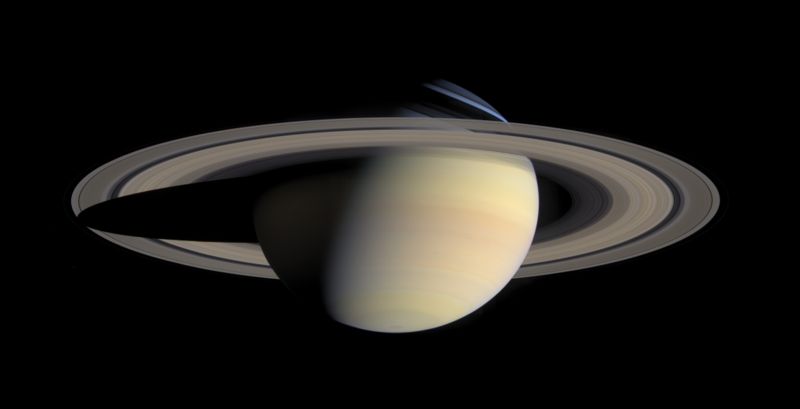Image:Saturn from Cassini Orbiter (2004-10-06).jpg
From Wikipedia, the free encyclopedia
- Image
- File history
- File links

Size of this preview: 800 × 409 pixel
Image in higher resolution (8888 × 4544 pixel, file size: 5.4 MB, MIME type: image/jpeg)
|
|
This is a file from the Wikimedia Commons. The description on its description page there is shown below. |
|
|
Summary
| Target Name: | Saturn |
| Is a satellite of: | Sun |
| Mission: | Cassini |
| Spacecraft: | Cassini Orbiter |
| Instrument: | Imaging Science Subsystem |
| Product Size: | 8888 samples x 4544 lines |
| Produced By: | CICLOPS/Space Science Institute |
| Primary Data Set: | Cassini |
| Full-Res TIFF: | PIA06193.tif (28.28 MB) |
| Full-Res JPEG: | PIA06193.jpg (5.663 MB) |
The Greatest Saturn Portrait ...Yet
While cruising around Saturn in early October 2004, Cassini captured a series of images that have been composed into the largest, most detailed, global natural colour view of Saturn and its rings ever made.
This grand mosaic consists of 126 images acquired in a tile-like fashion, covering one end of Saturn's rings to the other and the entire planet in between. The images were taken over the course of two hours on Oct. 6, 2004, while Cassini was approximately 6.3 million kilometers (3.9 million miles) from Saturn. Since the view seen by Cassini during this time changed very little, no re-projection or alteration of any of the images was necessary.
Three images (red, green and blue) were taken of each of 42 locations, or "footprints," across the planet. The full colour footprints were put together to produce a mosaic that is 8,888 pixels across and 4,544 pixels tall.
The smallest features seen here are 38 kilometers (24 miles) across. Many of Saturn's splendid features noted previously in single frames taken by Cassini are visible in this one detailed, all-encompassing view: subtle colour variations across the rings, the thread-like F ring, ring shadows cast against the blue northern hemisphere, the planet's shadow making its way across the rings to the left, and blue-grey storms in Saturn's southern hemisphere to the right. Tiny Mimas and even smaller Janus are both faintly visible at the lower left.
The Sun-Saturn-Cassini, or phase, angle at the time was 72 degrees; hence, the partial illumination of Saturn in this portrait. Later in the mission, when the spacecraft's trajectory takes it far from Saturn and also into the direction of the Sun, Cassini will be able to look back and view Saturn and its rings in a more fully-illuminated geometry.
Source: http://photojournal.jpl.nasa.gov/catalog/PIA06193 ( direct link)
|
|
This is a featured picture on Wikimedia Commons. We believe it is one of the finest images on Commons. If you have an image of similar quality that can be published under a suitable copyright license, be sure to upload it, tag it, and nominate it. |
|
|
This image was selected as a picture of the day for May 27, 2007. It was captioned as followed: English: Natural colour view of Saturn, composed from a series of pictures taken by the Cassini spacecraft.
English: Natural colour view of Saturn, composed from a series of pictures taken by the Cassini spacecraft.
日本語: カッシーニ探査機が撮った 土星の自然色写真。
한국어: 카시니 우주 탐사선이 찍은 일렬의 사진으로 합성된 토성의 자연색 사진.
Polski: Obraz Saturna w kolorach naturalnych, złożony z serii zdjęć wykonanych przez sondę Cassini.
繁體中文: 土星的自然色照片,由 卡西尼號探測器所拍攝的連續照片組成
|
Licensing
 |
This file is in the public domain because it was created by NASA. NASA copyright policy states that "NASA material is not protected by copyright unless noted". ( NASA copyright policy page or JPL Image Use Policy). Warnings:
|
|
File links